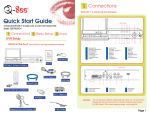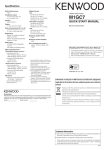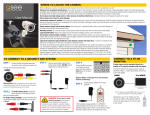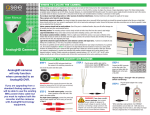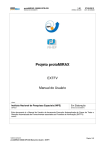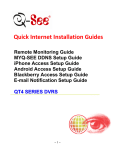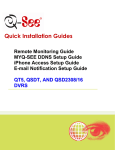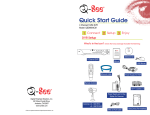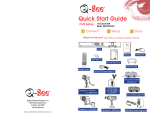Download Q-See QH8013Z Technical Manual
Transcript
User Manual MODEL QH8013Z Outdoor SDI Pan-Tilt-Zoom Dome Camera with 20x Optical Zoom 1 Introduction Thank You for Choosing a Q-See Product! All of our products are backed by a conditional service warranty covering all hardware for 12 months from the date of purchase. Additionally, our products also come with a free exchange policy that covers all manufacturing defects for one month from the date of purchase. Permanent upgrading service is provided for the software and is available at www.QSee.com. Be certain to make the most of your warranty by completing the registration form online. In addition to warranty and technical support benefits, you’ll receive notifications of product updates along with free downloadable firmware updates for your DVR. Register today at www.Q-See.com! Please see the back of this manual for exclusions. This manual is written for the QH8013Z SDI PTZ camera and was accurate at the time it was completed. However, because of our ongoing effort to constantly improve our products, additional features and functions may have been added since that time and on-screen displays may change. We encourage you to visit our website at www.Q-See.com to check for the latest product announcements. You can also find technical details and an electronic version of this manual on the QH8013Z’s product page on our site. Throughout the manual we have highlighted warnings and other important information that will assist you in operating your new system in a safe and trouble-free manner. Please take the time to read and follow all instructions and pay attention to alerts as shown below: IMPORTANT! Red boxes with this icon indicate warnings. To prevent possible injury or damage to the product, read all warnings before use. NOTE! Text in blue boxes with the Information icon offer additional guidance and explanations about how to make the most out of your system. For your safety and to protect your camera To prevent damage to your Q-See product or injury to yourself or to others, read and understand the following safety precautions in their entirety before installing or using this equipment. WARNING! ELECTRIC SHOCK RISK! © 2014 Q-See. Reproduction in whole or in part without written permission is prohibited. All rights reserved. This manual and software and hardware described herein, in whole or in part, may not be reproduced, translated, or reduced to any machine-readable form without prior written approval. Trademarks: All brand names and products are trademarks or registered trademarks of their respective owners. Q-See is a registered trademark of DPS, Inc. Disclaimer: The information in this document is subject to change without notice. The manufacturer makes no representations or warranties, either express or implied, of any kind with respect to completeness of its contents. Manufacturer shall not be liable for any damages whatsoever from misuse of this product. 2 nCare should be taken during transportation, storage and installation of this camera to avoid rough handling, dropping, or other abuse in order to prevent damage to the optics or components inside the camera. nCamera should be installed in accordance with electrical standards including keeping the camera and cable away from high voltage, using a transient voltage surge protector (UL-1449) and using only the rated power supply. nDo not use strong or abrasive cleaners on camera body or lens. Use a damp cloth for cleaning the housing and a lens cloth for the optics. nDo not attempt to disassemble the camera beyond removing the case to adjust settings. Only authorized, trained technicians should service this camera. nThe camera should not be immersed in water and should be mounted in a sheltered location. Do not point camera directly at the sun or other strong light source. Rev. 1.0 2/3/14 3 FEATURES & SPECIFICATIONS IMPORTANT! This camera will only work with SDI DVR systems! It will not work with systems using analog video technology. Your DVR must also support 1080P resolution. Product Features Your camera offers the following features: n 1080p High Definition resolution n Weatherproof IP66 rating for indoor and outdoor use n Built-in heater and fan for continued operation in severe weather. n Built-in lightning-proof components to prevent damage by lightning strike or power surge. n Automatic and manual focus n Automatic and manual white balance n Automatic brightness controls n RS485 control with support for Pelco D and Pelco P protocols n Automatic Day and Night (low light) modes. n 0.5 lux minimum for color, .01 lux minimum for B&W and .05 lux minimum for DSS PTZ Module Features nHorizontal scanning: 360° rotation n Vertical tilt: 90° n Manual rotation/tilt speed: .5°-120°/second n Preset rotation/tilt speed: .up to 400°/second n 128 preset positions - 80 preset positions and 48 special function settings. n Preset options for 8 Patrol, 4 Trace, 2 Auto Scan, Auto Pan functions n 20x optical zoom n Fully-functional built-in decoder - all data is saved inside of the module to retain settings in case of power loss. n Adjustable speed depending on zoom length to ensure clear image n Baud rate changeable through on screen menu QH8013Z PTZ SDI Dome Camera Specifications Image Sensor 1/3” Panasonic CMOS Image Resolution 1920 x 1080 Lens Size 4.7 mm to 94 mm (20X Optical Zoom) Angle of View (horizontal) 3° to 58° Address Range 1-128 On Screen Display English Backlight Compensation Auto Gain Control Automatic/Manual Wide Dynamic Range Yes Supported Protocols Pelco D, Pelco P Baud Rate 1200b/2400b/4800b/9600b Preset & Cruise Patterns 128, including: 8 Patrol, 4 Trace, 2 Auto Scan, Auto Pan Minimum Illumination (in Lux) Color 0.5/B&W 0.1/ 0.05 DSS On Auto ICR Connector Types HD-SDI BNC, Power, RS485, RS422 Compatible Systems 1080P SDI DVRs Power Supply 24V Power Consumption 9W (24W Heater on) Weatherproof Yes IP Rating 66 Body Construction Metal Mounting Hardware Screws, wall mount Weight 11 lbs Dimensions (WxH) 8.75 x 12.25 Operating Temperature -4°F – 140°F Color White DEFAULT SETTINGS Channel/Address: 1 Baud Rate: 9600 Protocol: Pelco P 4 5 PARTS & CONNECTORS PREPARING YOUR CAMERA Your camera is packed to protect internal components from damage during shipping. These packing items MUST BE removed before installation or they can interfere with its operation. 5 6 7 8 9 6 1 2 3 4 Use care when handling and opening the camera to avoid damage. Fabric gloves have been included in order to help prevent smudges and fingerprints on the camera lens or inside the clear dome. Loosen the four screws surrounding the camera dome to remove the camera cover. Use the included hex wrench. Do not remove the screws completely from the camera cover. A retaining wire will keep the cover attached to the camera body. x4 Remove the camera pad, lens cap and protecting collar. 1 SDI Video 2Power 3 RS485 Connector 4 RS422 Connector 5 Safety Wire 6 Upper Camera Body 7 Camera Body 8 Retaining Wire 9 Camera Dome Replace the camera cover making certain that there are no smudges or debris on the camera lens or inside the clear dome. A NOTE ON CAMERA ADDRESS AND COMMUNICATION Unlike conventional security cameras, PTZ cameras require an address to communicate with the DVR and operate properly. Unlike analog PTZ cameras, settings on this SDI camera are made within the camera’s internal menu (covered later in Camera Menu). This camera is set with a default address of 1, and a baud rate (communication speed) of 9600 and it will use the Pelco P communication protocol. This means that your camera should be connected to Channel 1 of your DVR and the baud rate and protocol settings on your DVR should be set to match - at least long enough for you to change those settings, if desired. The default baud rate of 9600 allows you to effectively control the camera up to 800 feet away. Areas with electronic interference may require heavier or shielded cabling. The higher the setting (may be required by some DVRs), the shorter the control distance. If you make any changes to the baud rate and communication protocol within the camera, you will need to make matching changes in the DVR itself in order to control the camera without problem. NOTE! Some DVRs may require specific connection speeds. Check your system’s manual for the proper settings. 7 PTZ CONTROL CONNECTION CONNECTING THE CAMERA We recommend connecting your camera to your DVR before mounting it as a “dry run” to make sure everything is operating normally. It is much easier to correct a situation such as a forgotten lens cap while the camera is on a table than it is when the camera is mounted high up on a wall. If you will need to change the camera settings such as address, baud rate or communication protocol, this would be the time to do so (see Camera Menu later in this manual). POWER AND VIDEO CONNECTION STEP 1. Connect the BNC and power leads from the camera to the matching connectors on the included video/power/ control cable. IMPORTANT! When connecting the power and video cable between the camera and the DVR, the “male” power end connects to the matching power lead on the camera. In addition to connecting the power and video leads to the camera, you must also connect the two control wire leads to the RS485 ports in the alarm block on the back of the DVR. These blocks can vary in layout as shown below, but the ports used by your DVR are generally labelled “RS485”, “PTZ” or “P/Z”. The RS422 connector will not be used. As seen in the picture on the upper right, the wire leads from the camera are two different colors and are labelled. They are also pre-installed into a block which plugs into a matching receptacle on the extension cable. The control wire leads at the other end of the extension cable must be inserted into the ports on the back of the DVR. In the case of the RS485 ports being marked as positive (+) and negative (-), the wire designated RS485A (red tip) is the positive lead while the wire marked RS485B (yellow tip) is to go into the negative port. PTZ blocks either have small screws to above each port to secure the wire or require a lock above the port to be depressed with an object like a small screw driver in order to fully insert the wire. In the latter, when the lock is released, an internal clamp will keep the wire firmly secured in the port. If the wire can easily be removed from the port, then it isn’t secure and you can experience control difficulties until it is properly attached. Space permitting, multiple PTZ cameras may be connected to the same ports. They will each require a different address. If you need to mount the camera further than allowed by the included 100’ STEP 2. Connect the power lead on the other end of the video/power cable into the included 24V 2.2A power supply. STEP 3. Connect the BNC connector on that same end of the cable to the Video In port marked 1 on the back of the DVR. Some examples of PTZ blocks. One using screws (left) and two using spring-loaded locks. AUDIO IN 1 2 VIDEO IN 3 4 1 2 3 4 You can now plug the camera’s power adapter into a surge protector and turn it on. To protect your investment, we STRONGLY recommended using a surge protector that is UL-1449 rated, for a clamping voltage of 330 or lower, a Joule rating of at least 400 and a response time of 10 nanoseconds or less. 8 cable, you will need to get a shielded RG59 video/ power cable that runs the entire didstance and a pair of 24-gauge wires to connect to the RS485 block. SDI cables should not be extended. Once you have made your connections, you will need to make settings on the DVR in order to control it. You will need to consult your DVR’s manual for this procedure, but a sample screen (from a Q-See QT-series DVR) is shown on the right. P.T.Z Serial Port Advanced CH Address Baud Rate 1 Enable 1 2400 PELCOD 2 2 9600 Protocol PELCOP 3 3 9600 PELCOP 4 4 9600 PELCOP Simulative Cruise All 9600 PELCOP Default Apply Exit 9 INSTALLING THE CAMERA MOUNTING THE CAMERA When installing your camera, it is important to select a proper site not only for field of view, but for other considerations as well: STEP 1. Run the power/video/data extension from the DVR to the camera’s location. Distance from viewing/recording device. The further the camera is from the DVR or monitor, the higher the chances of signal degradation. Typical 75Ω Video Cable provides acceptable signal at distances up to 200’ (30m). At greater distances, UL-Listed shielded RG59 should be used. The camera’s power supply should be located as near to the camera as possible when the distance exceeds 200’ as the power level will drop over extended distances resulting in a decrease in video quality. STEP 2. Use the mounting bracket to mark the position for the mounting holes. Ensure that the camera will be horizontal by using a spirit or bubble level. Also mark location of hole for cables to pass through the mounting surface. This hole should be large enough to prevent the cable from catching on anything and allowing the cable extending from the camera to be easily pushed through. 4 Do not place near high voltage wires or other sources of electrical interference. Electrical interference will degrade the quality of the signal. STEP 3. Drill the mounting and cable holes. Place camera out of reach to avoid damage. Avoid direct exposure to weather. Do not place the camera where rain or snow will hit the lens directly nor should the camera be placed so that the sun or bright light shines directly into the lens. Your camera is weatherproof, but it will not work when submerged in water. Ensure that all power and video connections are not directly exposed to water and are protected from the elements. STEP 4. Mount the bracket on the desired surface using the included hardware. 5 Do not place camera behind a window. If there is a light source behind the camera, it can cause a reflection in the window that will obscure events on the other side of the glass. Light levels should be approximately the same between camera and target area. A camera in a brightly-lit area looking into a shaded area, or vice versa, may produce inadequate results. The above are guidelines and the optimal location for your camera will depend on your unique circumstances. As a general rule, the locations highlighted in green in the picture to the right indicate the best locations to mount your camera. Both locations are sheltered from rain or snow and offer good sight lines to allow your camera to monitor a wide area. Because your camera is weatherproof, it requires less protection than weather-resistant cameras and it can be placed in more exposed locations if needed. Keep in mind that this camera is designed to operate between -4°F – 140°F (-20°C to 60°) with a relative humidity of up to 95%) and consider wind chill and other environmental factors when selecting your location. Your camera comes with a wall mount (a ceiling mount is available separately from q-seestore.com. Where you locate your camera will determine which mount you will need to use. The mounting surface must be sturdy and able to hold at least five times the camera’s total weight of 11 pounds (5kg). 10 7 8 Depending on your situation, you may want to have the extension cable leads pulled through the mount to make it easier to connect to the camera. If you have access to the other side of the mounting surface, then plan to pull them through the mount so you can connect to the extension cable from there. STEP 5. Attach the mounting collar to the camera body with the three bolts. Position collar so that safety wire attachment point faces the rear of the camera. Make sure that the camera’s cable ends pass through the collar and are not constricted. STEP 6. Connect the camera cable leads to the leads on the extension cable and carefully push/pull the cables through the mount taking care to not pinch or bend cables nor disconnect the leads STEP 7. Rotate the camera body/collar assembly to screw it onto the mount. STEP 8. Clip the safety wire onto the attachment point on the collar. IMPORTANT! Do not allow the camera cable to be subject to pinching, tight bends or other severe constriction as part of its final installation position as this can damage the cable over time leading to signal loss or potential fire hazard. Take precautions to ensure a clear work area below the camera mounting point during installation as a falling camera can cause injury or damage. 11 OPERATION WITH DVR The QH8013Z can be controlled using the PTZ controls on the DVR to which it is connected. In addition, as covered in the next section, Camera Menu (Page 14), it can be operated using its own menu. Most users find the DVR operation more convenient because of the ease of access. Depending on the software used, it is also possible to control the PTZ camera remotely when you are logged into the DVR via the Internet, a remote monitoring program or a smartphone app. You can also program a cruise - also called “scan” or “tour” on some systems - so that the camera will perform a set search pattern of the surrounding area. These settings can be made on the DVR or in the camera itself. As mentioned in the section on Connecting the Camera, you will need to consult your DVR’s manual for specifics on how to enable your system to control your camera. That manual should also contain instructions on how to program points and cruises for the camera to use. If the DVR channel that your camera is connected to is set to record when motion is detected, the movement of the camera itself will result in constant recording. GENERAL CRUISE SETUP PROCEDURE While each DVR system is different in the specifics of how to set up a scan, there are general similarities. Most involve the process of pivoting the camera to the desired starting point and saving that point. Then, by selecting one or more points for the camera to move to in sequence, a scan path is built which is then saved. Often, multiple paths can be saved within the DVR, which can be selected for later use. 01 02 03 04 05 06 07 08 All Zoom Focus Iris No. 1 Save Speed: 5 These points can be set using a special PTZ keyboard, or by using the PTZ controls on the DVR itself. Two such on-screen interfaces are shown at right; the QT-Series (top) and QCseries (bottom). In both examples, directional control is achieved by using the DVR’s mouse to click on one of the directional arrows. As long as the arrow is held, the camera will move in that direction. The camera can continuously rotate full-circle if desired. The camera’s elevation is limited to 90°. On both control panels there are controls for zoom, focus and iris (light level). The QH8013Z has a 20x optical zoom lens which will adjust between 4.7 and 94mm. The camera has an auto-focus feature and can be manually adjusted as well. Of the 128 presets available on the camera, presets 1-89 may be used for defining camera positions. The remainder are commands for the camera. Of that latter group, Preset 95 allows access to the camera’s internal menu. 12 EXAMPLE 1: SETTING A CRUISE This example is based on using a QT-Series DVR without an attached PTZ keyboard. Your DVR’s specific commands may differ slightly. Please consult your system’s manual. STEP 1. In your DVR’s PTZ Settings window, select the Advanced tab and then Preset 1. STEP 2. Rotate the camera to the desired position using the arrow controls. STEP 3. Click Save STEP 4. Select Preset 2. STEP 5. Rotate camera to desired second location. STEP 6. Click Save You may repeat Steps 4-6 for additional positions if desired. STEP 7. Return to the PTZ window and click on the Cruise button for your channel. STEP 8. Click Add. STEP 9. Double-click on the new cruise setting to begin loading your presets. STEP 10. Click on the + button to open the Preset pop-up window and select your starting preset point, speed and stop time. Speed: 1-8 with 8 being the fastest Time: This is the time the camera will stay pointed at this location. STEP 11. Repeat for each preset - up to a maximum of 16 per cruise. P.T.Z Serial Port CH Advanced Preset Cruise Track 1 Setting Setting Setting 2 Setting Setting Setting 3 Setting Setting Setting 4 Setting Setting Setting 5 Setting Setting Setting 6 Setting Setting Setting 7 Setting Setting Setting 8 Setting Setting Setting Default Apply Exit 01 02 03 04 05 06 07 08 All No. Zoom 1 Focus Save Iris Speed: 5 01 02 03 04 05 06 07 08 All Zoom Start Track Focus Preset Iris Cruise preset 101 Start Auto Scan Start Cruise Speed: 5 STEP 12. Click OK save your settings and close the windows until you reach the PTZ Settings window. Click Apply to save all of the settings. STEP 13. Open the PTZ Controls from the Control Bar, select your cruise in the pull-down and click to begin. EXAMPLE 2: SETTING A TRACK An alternate method is to utilize the Track settings - also found in the Advanced tab. Click the Track button for the right channel, use the directional controls to point the camera at your desired starting point and then click Start Record. The DVR will then record your movements, including delays at selected spots. Click Stop Record to end. Clicking on Start Track in the PTZ Control window will start the camera on its track. 13 SYSTEM SETUP WINDOW CAMERA MENU The QH8013Z’s internal menu provides another method to control its movements as well as allowing the user to make settings to the camera itself. These settings range from changing the camera’s address and baud rate to adjusting the color balance, day/night mode and zoom speed. In your DVR’s PTZ Controls, select Preset 95 in the pull-down and click to enter the camera’s internal menu. 01 02 03 04 05 06 07 08 All Zoom Start Track Focus Preset Iris Cruise preset 101 Start Auto Scan Start Cruise As the name says, this is where you will make your changes to the camera’s general settings. Auto PT Flip - When this is enabled, and the camera is programmed to go beyond 90° (straight down), the camera will quickly rotate so that the lens will be able to continue to elevate with the image right side up. Language Setup - English is the only available option. SYSTEM SETUP 1 2 3 4 5 6 7 0 RS422 SETUP Speed: 5 RS422 Setup - Change your camera’s address, baud rate and communication protocol. MENU NAVIGATION Use the PTZ “up” and “down” directional arrows to move around in the menu. Click on the right arrow to: ∙ Select an option from a menu. ∙ Enter a submenu designated by “ ” ∙ To confirm a setting (i.e., clicking Enter) Move Up Move Left Move Right/ “Enter” Move Down The left arrow is used to go back to the menu item. To go up one level (i.e.; back to the Main menu from a submenu), click on Return. To go up one level (i.e.; back to the Main menu from a submenu), click on 0 Return. SYSTEM INFORMATION WINDOW This window shows the current settings for the camera. The menu cannot be navigated. 14 MAIN MENU 1 2 3 4 5 6 7 0 SYSTEM INFORMATION SYSTEM SETUP CAMERA SETUP PRESET SETUP DOME FUNCTION DISPLAY SETUP LOAD DEFAULT EXIT SYSTEM INFORMATION 1 2 3 4 5 6 7 0 VERSION: V1.10 CAMERA: HD20T TEMPERATURE:72°F DATE: 01-24-14 DOME ID: 001 PROTOCOL: PELCO-P BAUD RATE: 9600 RETURN Leave “RS422/ID SEL” set to S/W (software). If you change any of the other settings in this window, you will have to change the settings in the DVR to match. Dome ID - This is the camera’s address. It can range from 1-255. AUTO PT FLIP: ON LANGUAGE SETUP RS422 SETUP DATE SETUP TITLE SETUP NORTH SETUP HOME POSITION EXIT 1 2 3 4 0 RS422/ID SEL:S/W DOME ID: 001 PROTOCOL: PELCO-P BAUD RATE: 9600 EXIT Date Setup, Title Setup - These will appear on screen (and be recorded by the DVR as part of the video) only if enabled in the Display Setup option. Your DVR also has the ability to include this information. If you choose to utilize these, use the directional arrows to navigate through the entries. When complete, select Preset 001 from the pull down and click to save it. Or, select Preset 002 and click to exit out of the menu without saving changes. North Setup - You can choose a point that the camera will regard as “North”. If enabled in the Display Setup option, the camera will display its position in degrees from its “North”. In addition to the horizontal position, the camera will consider 0° (horizontal) as part of the setting and will show the vertical depression from that point as well. Home Position - You can cause your camera to return to a specific “Home” position after a set period of time (5 seconds to 3 minutes). By using this setting, you can have the camera monitor a specific point until and alarm (set up in the DVR) triggers an action, such as a cruise. Afterwards, it will return back to its starting point. The date, time, and position displays will only appear on screen if enabled in the Display Setup menu (page 20). 15 CAMERA SETUP WINDOW CAMERA SETUP Settings affecting the camera’s video image are located in this menu. 1 2 3 4 5 6 0 CAMERA CONTROL - This submenu contains settings to maximize image quality. BLC - Back Light Compensation. This can be set either On or Off and allows the camera to digitally adjust the image to make items in the foreground clearer when there is a bright light behind them. HLC - High Light Compensation. When this is enabled, bright lights, such as headlights, will be digitally blacked out in order to make other details clearer. An example would be to see a license plate that would normally be washed out by the vehicle’s headlights. CAMERA CONTROL IMAGE SETUP FOCUS NEAR LIMIT: 1M ZOOM SPEED: MIDDLE DZOOM: OFF PAL/NTSC NTSC EXIT CAMERA CONTROL 1 2 3 4 5 6 7 8 0 HLC Level - Adjusts the level of compensation. Examples of BLC and HLC are below and below right: BLC: OFF HLC: OFF HLC LEVEL: 20 3D-DNR: LOW COLOR LEVEL:08 SHARPNESS: 08 IMAGE FLIP: OFF GAMMA: DEFAULT RETURN IMAGE CONTROL - This submenu contains more controls for the camera’s video. Brightness - Adjust the brightness from dark (00) to light (20). AGC - Automatic Gain Control “amplifies” the image for more detail, but it may be grainy. Shutter Mode - Manual or Automatic Shutter - Only active when the shutter is in manual mode. The lower the value, the brighter the image. IMAGE CONTROL 1 2 3 4 5 6 7 8 0 Focus Near Limit - This allows you to set the closest distance that the camera can focus on. This is useful if there is some item, like part of the building, that the camera will automatically focus upon at the expense of items in the distance. Zoom Speed - Adjusts the zoom speed. Digital Zoom - Allows the camera to electronically zoom beyond the camera’s 20x optical limit up to 240x. Objects in digitally zoomed video will not be as clear as those in optical zoom. Video Format - NTSC (Americas) or PAL (Europe, Asia, Brazil, Argentina and Uruguay) 3D-DNR - 3D Digital Noise Reduction reduces the graininess of images in low-light conditions. Color Level - Adjusts the on-screen color levels. Settings range from 1 to 14. Sharpness - Adjusts image definition. Settings range from 1 to 20. Image Flip - The camera’s image can be flipped horizontally, vertically or both. Gamma - Adjusts the contrast of the video. 16 If you wish to program your camera’s movements in the camera rather than the DVR, this menu lets you set up the preset points. BLC On Title Display - You can name preset points if desired in the Preset Setting, (option 3). This option lets you display the name on screen. HLC Off HLC On 10 05 AUTO 01 ATW 15 15 AUTO WB Mode - White Balance allows you to adjust to the specific light conditions. Choose from Auto, Manual and ATW (Automatic Tracking White) where the camera attempts to keep a “neutral” white. MWB Red Gain/MWB Blue Gain - These two settings are only available when the white balance mode is set to Manual and they affect the red and blue color levels. Day/Night Mode - The camera will normally adjust between day (color) and night (black and white) modes automatically based on light levels. However, you can set the camera to operate permanently in one mode or the other. PRESET SETUP WINDOW BLC Off BRIGHTNESS: AGC: SHUTTER MODE: SHUTTER: WB MODE: MWB RED GAIN: MWB BLUE GAIN: DAY NIGHT MODE: RETURN PRESET SETUP 1 2 3 4 5 0 TITLE DISP: CUR PRESET NO: PRESET SETTING DEL CUR PRESET DEL ALL PRESET EXIT OFF 001 CREATING A PRESET POINT STEP 1. Use the DVR controls to position the camera STEP 2. Return to the camera’s menu by selecting Preset 95 STEP 3. Set the number of the current preset point (option 2) STEP 4. Enter the Preset Setting submenu (option 3) STEP 5. Enter a title, if desired. Select Preset 001 from the DVR’s pull down and click to save this point. Or, select Preset 002 and click to exit out of the menu without saving changes. 17 DOME FUNCTION WINDOW TASK SETUP - You can designate up to eight separate periods in a day and assign the camera specific tanks for each period. If Tasks are enabled, the Home Position function (page 15) will not operate. DOME FUNCTION This menu lets you take the preset points created in the previous menu and put them together into a maximum of eight patrols with 16 points each. A patrol, is the same thing as a cruise on the DVR. 1 2 3 4 5 6 7 0 CREATING A PATROL STEP 1. Select Patrol Setup STEP 2. Set the Patrol Number (option 1) You may create up to 8. STEP 3. Enter the Edit Current Patrol submenu PATROL SETUP TASK SETUP TRACE SETUP DAY NIGHT DOME FUNCTION NEW PASSWORD CHANGE PASSWORD RETURN 1 2 3 4 0 PATROL NO: 1 EDIT CUR PATROL RUN CUR PATROL... DEL CUR PATROL RETURN ALARM SETUP - This is not functional in this camera. For an alarm-triggered action, please use your DVR’s alarm settings to run a pattern, track or cruise that has been saved in the DVR’s PTZ controls. You can navigate between points using the left and right arrow keys. Use the up and down arrow keys to change the number values. Clicking on the Iris + button in the DVR’s PTZ Control window will increase a number value by 10. Clicking on the Iris - button will decrease the value by 10. If you wish to use less than 16 preset points in your patrol, set the unused points to 000. Run Current Patrol - This will run the selected patrol until the camera is instructed to do otherwise. Speed: 5 18 TRACE SETUP This will create a path that the camera will follow, including horizontal and vertical positions along with zoom and focus settings. This differs from the Patrol in that the camera will record your actions and save it as a Trace. This is identical to the Track feature on QT-Series DVRs. Each Trace can last up to 3 minutes. If that time is exceeded, the camera will save the trace to that and 05 exit to 06 01 up 02 03point04 the Trace Setup menu. FORMAT: PRENO/TIME<SEC> 01: 001/005 02: 002/005 03: 003/005 04: 004/005 05: 005/005 06: 006/005 07: 007/005 08: 008/005 09: 009/005 10: 010/005 11: 011/005 12: 012/005 13: 013/005 14: 014/005 15: 015/005 16: 016/005 CALL 1 TO STORE CALL 2 TO CANCEL Delete Current Patrol - Deletes the selected patrol. TASK SETTING 00:00-00:00 NONE: 00 00:00-00:00 NONE: 00 00:00-00:00 NONE: 00 00:00-00:00 NONE: 00 00:00-00:00 NONE: 00 00:00-00:00 NONE: 00 00:00-00:00 NONE: 00 00:00-00:00 NONE: 00 CALL 1 TO STORE CALL 2 TO CANCEL CREATING A TASK STEP 1. Set a start and end time using 24 hour (military) time. STEP 2. Choose a task: Random, Point to Point, Preset Point, Patrol or Trace. STEP 3. Select Patrol, etc. you want. STEP 4. Select Preset 001 from the DVR’s pull down and click to save this point. Or, select Preset 002 and click to exit out of the menu without saving changes. PATROL SETUP The 16 available preset points for your patrol are arranged in two columns with the delay (in seconds) for that point immediately to its right. You can have the camera stay on a point between 5 and 240 seconds (4 minutes). 1 2 3 4 5 6 7 8 01 02 03 04 05 06 Zoom STEP 1. Set the trace number STEP 2. Select Trace Setting STEP 3. Click on the Iris - button to begin recording. STEP 4. Use the directional, zoom, function and iris controls to create your trace. STEP 5. When Speed: 07 08 All complete, select Preset 001 from the DVR’s pull down and click to save your trace. Zoom Focus Preset Iris Cruise 5 Trace Run- SelectStart this toTrack run your Trace. Focus Preset Iris Cruise preset 101 Start Auto Scan DAY/NIGHT This setting allows you to set what time the camera will operate in day (color) mode and night (black Start Cruise and white) mode regardless of the light level. For this to be utilized, you must have set the date and time in the System Setting menu (see page 15). Select Preset 001 from the DVR’s pull down and click to save your settings. 19 p NEW PASSWORD/CHANGE PASSWORD These features are not operational on this camera. If you are concerned about the security of your camera - or your system for that matter - set up specific user accounts for anyone who has access to your DVR. On QT-series DVRs you can limit user permissions to specific functions. Treat these user accounts as you would a user account on a computer as far as password difficulty and sharing with others. DISPLAY SETUP WINDOW This is the menu that allows you to enable the time, temperature, position and other displays that you may have set up in other menus. LOAD DEFAULT WINDOW You can reset your camera back to the factory default settings through this menu. Master Reset - This will reset the camera and active menu but will not clear settings such as the camera’s name, baud rate, preset points, patrols or etc. EXTENDING CABLE Your camera comes with a pre-built 100’ RG59 power/video/data cable. If a longer run is desired, the included power supply will power the camera up to 300 feet away, but you must use a continuous shielded RG59 cable without any breaks in it. A communication wire will also need to be run in parallel in order to control the camera. To maintain video quality: · SDI video requires the use of shielded cables. · Always check state and local laws before installing cameras. (2011 NEC 820.44) Other notes: · If a cable run exceeds 800ft, we recommend using RG-6 coaxial cable which is available at most retail building supply companies. · Cable runs over 300 feet will require a larger camera power supply or for the power supply to be only 300 feet away from the camera. Master Clear - Resets the camera and clears all user settings. System Reboot - Reboots the camera, but does not clear any settings. Firmware Update - The camera’s firmware can be updated using the RS422 port. This should only be done using a firmware package provided by Q-See. CAMERA PRESETS The commands listed in the first table are hard-wired into the camera. They can be accessed using the DVR’s PTZ Control window and clicking on . Those in the second table have multiple functions depending on where they are accessed or set. 20 Preset Function Preset Function 90 Run Trace 1 91 Set Random Scan 91 Run Patrol 1 92 Run Patrol 2 93 Run Patrol 3 94 Run Patrol 4 95 Open camera menu 97 Random scan 98 Point to Point scan Task: Return to start point 92 Set left border of Point-toPoint scan 93 Set right border of Point-toPoint scan 21 TROUBLESHOOTING Problem Cause and Solution No image or movement when powered up Check the power cable for damage and connection Ensure that the power outlet is live Q-SEE PRODUCT WARRANTY Q-See is proud to back all of our products with a conditional service warranty covering all hardware for 12 months from the date of purchase. Additionally, our products also come with a free exchange policy that covers all manufacturing defects for one month from the date of purchase. Permanent upgrading service is provided for the software. Check the power supply The image is not stable The image is blurry Check that the video connection is secure Liability Exclusions: Check the power supply. The camera cannot be more than 300’ away. Any product malfunction or abnormalities in operation or damage caused by the following reasons are not within the free service scope of our company: Check the camera dome for dirt or smudges Use a damp, soft cloth to clean the dome. Do not use abrasive cleaners or solvents. Avoid harsh chemicals including acetone as they may permanently fog the plastic. 1. Equipment damage caused by improper operation. 2. Improper equipment operation environment and conditions (e.g., improper power, extreme environmental temperatures, humidity, lightning and sudden surges of electricity). Video noise Check for electromagnetic interference near camera (such as a generator, large refrigeration unit, etc.) 3. Damage caused by acts of nature (e.g., earthquake, fire, etc). Normal camera startup and self-check but no image Check video cable connection. 5. Product sold over 12 months ago. Normal camera startup and self-check but no control Check if RS485 cable is properly connected. Abnormal camera startup and selfcheck and unstable control Check that protective foam has been removed 22 4. Equipment damage caused by the maintenance of personnel not authorized by Q-See. Remove protective lens cap Check that camera address, baud rate and protocol are correct and match the settings on the DVR In order to fulfill the terms of your warranty, you must complete the registration process after purchasing our product. To do this, simply fill out the User’s Information Card on our website at www.Q-See.com Check that you are using correct power supply 23 QUESTIONS OR COMMENTS? CONTACT US 24/7 Technical Resources, Knowledge Base and more at www.Q-See.com/support Live Support Mon.-Fri. 6am to 7pm Sat and Sun 9am to 5pm Pacific time Digital Peripheral Solutions, Inc. 8015 E. Crystal Drive Anaheim, CA 92807 24













